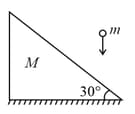Two bodies of same mass tied with an inelastic string of length lie together. One of them is projected vertically upwards with velocity . Find the maximum height up to which the centre of mass of system of the two masses rises.

Important Questions on Centre of Mass, Momentum and Collisions
A uniform thin rod of mass and length is standing vertically along axis on a smooth horizontal surface, with its lower end at the origin . A slight disturbance at causes the lower end to slip on the smooth surface along the positive -axis, and the rod starts falling.
(i) What is the path followed by the centre of mass of the rod during its fall?
A uniform thin rod of mass and length is standing vertically along -axis on a smooth horizontal surface, with its lower end at the origin . A slight disturbance at causes the lower end to slip on the smooth surface along the positive -axis, and the rod starts falling.
(ii) Find the equation of the trajectory of a point on the rod located at a distance from the lower end. That is the shape of the path of this point?
A block of mass with a semicircular track of radius , rests on a horizontal frictionless surface. A uniform cylinder of radius and mass is released from rest at the top point (see Fig). The cylinder slips on the, semicircular frictionless track. How far has the block moved when the cylinder reaches the bottom (point ) of the track? How fast is the block moving when the cylinder reaches the bottom of the track?
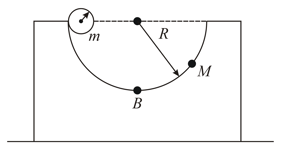
The bob of a pendulum released from to the vertical hits another bob of the same mass at rest on a. table as shown in figure. How high does the bob A rise after the collision? Neglect the size of the bob and assume the collision to be elastic.
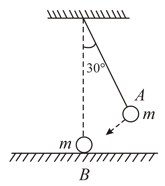
Three particles and of equal mass move with equal speed along the medians of an equilateral triangle as shown in figure. They collide at the centroid of the triangle. After the collision, comes to rest, retraces its path with the speed . What is the velocity of ?
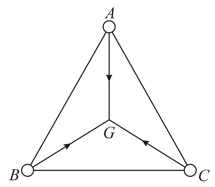
The Atwood machine in figure has a third mass attached to it by a limp string. After being released, the mass falls a distance before the limp string becomes taut. Thereafter both the mass on the left rise at the same, speed. What is the final speed? Assume that pulley is ideal.
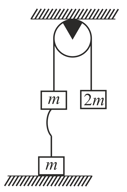
A ball of mass falling vertically with a velocity strikes a wedge of mass kept on a smooth, horizontal surface as shown in figure. The coefficient of restitution between the ball and the wedge is . Find the velocity of the wedge and the ball immediately after collision.
